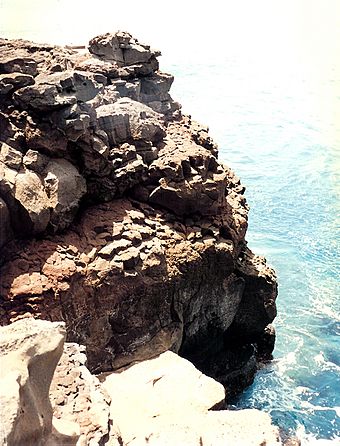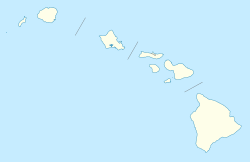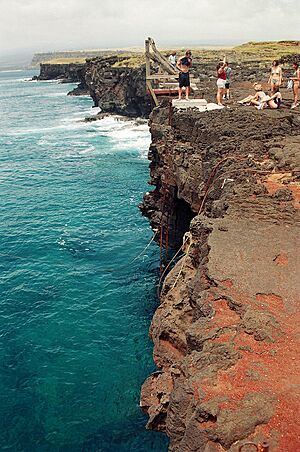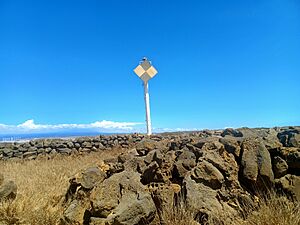Ka Lae facts for kids
|
South Point Complex
|
|

Rocky cliffs of Ka Lae
|
|
| Location | Big Island of Hawaii |
|---|---|
| Nearest city | Nā'ālehu |
| Area | 710 acres (290 ha) |
| NRHP reference No. | 66000291 |
Quick facts for kids Significant dates |
|
| Added to NRHP | October 15, 1966 |
| Designated NHLD | December 29, 1962 |
Ka Lae (which means "the point" in Hawaiian), also known as South Point, is a special place on the Big Island of Hawaii. It is the southernmost tip of the Big Island and also the southernmost point of all 50 United States.
This important area is officially recognized as a National Historic Landmark District. It is called the South Point Complex. Ka Lae is famous for its very strong ocean currents and winds. It is also home to a wind farm that helps make electricity.
Contents
Exploring Ka Lae's Geography
The name Ka Lae comes from the Hawaiian language. It simply means "the point." You might also hear it called South Point or South Cape.
Why is Ka Lae great for fishing?
Right off the coast of Ka Lae, different ocean currents meet. This makes it one of Hawaii's best places for fishing. You can find many fish here, like red snapper and ulua. Local people often fish from the high cliffs. They sometimes stand very close to the edge of the steep lava rocks.
However, swimming at Ka Lae is not safe because the currents are so strong. There is even a current called the "Halaea Current," named after a chief who was swept away and died there.
Ocean debris and wildlife at Ka Lae
Because of the strong currents, a lot of marine debris (trash from the ocean) collects along the coastline here. This area is very remote and hard to reach. It is probably the most trash-covered coast in Hawaii. This trash can be dangerous for animals. It can trap wildlife or float away again during storms.
Rare animals like Hawaiian monk seals and young hawksbill turtles use this shoreline. Both of these animals are endangered species. Groups like the Hawaii Wildlife Fund and the NOAA work together to clean up this important coastline.
How to get to Ka Lae
You can reach Ka Lae by driving on South Point Road. This road is about 12 miles long and is paved but narrow. It branches off from State Route 11. The turn-off is about 7 miles (11 km) west of Nā'ālehu village.
The strong winds at Ka Lae make some trees grow almost sideways. Their branches all point in the same direction, close to the ground. Near the end of the road, it splits. One path goes south to Ka Lae itself. The other path goes east to Papakolea Beach, which is famous for its unique green sand.
A Look at Ka Lae's History
Ancient Hawaiian settlements at South Point
Ka Lae is a very old place. It is one of the earliest places where people settled in Ancient Hawaii. This area has a long history that archaeologists have studied. Many people believe that this is where the first Polynesians landed in Hawaii. The Big Island is the closest Hawaiian island to Tahiti, and Ka Lae would have been the first land they saw.
You can still find the ruins of an ancient Hawaiian temple (called a heiau) and a fishing shrine here. Ancient Hawaiians also drilled many holes into the rock ledges. They used these holes to tie up their canoes. By tying long ropes to their boats, they could float out to sea to fish without being carried away by the strong currents. Scientists from the Bishop Museum dug up and studied this area in the 1960s.
The Ka Lae Lighthouse
A small lighthouse was first built at Ka Lae on March 5, 1906. In 1908, about 10 acres of land were set aside for the United States Coast Guard. They built a house there for the lighthouse keeper. When they built it, they were careful not to damage the old archaeological sites.
In 1929, a steel tower was built for the light. Then, in 1972, a new 32-foot (10-meter) concrete tower was built. This new lighthouse uses solar power to work.
Recent developments at Ka Lae

During World War II, the US Air Force built a landing strip called Morse Field at Ka Lae. This airfield was closed in 1953.
In 1961, Ka Lae was considered by NASA as a possible place to launch rockets with astronauts into space. However, it was thought to be too far away from other places. Later, it was used to launch smaller rockets to test instruments for the Air Force's Maui Space Surveillance Center.
The low latitude of Ka Lae also made it a good spot for private rocket launches. However, these plans were stopped because of high costs and local opposition.
A space tracking station operated here from 1964 to 1965. In the 21st century, the Swedish Space Corporation built a new ground station for tracking satellites and communicating with them. This station has two large 13-meter parabolic antennas. Also at Ka Lae are the large shortwave radio antennas of World Harvest Radio International.
Wind power at Ka Lae
In 1987, the Kamaoa Wind Farm started working. It had 37 large wind turbines that could produce a total of 7.5 megawatts of power. By 2006, these turbines were getting old and broken. They were finally shut down on August 15, 2006.
In August 2006, parts for a new set of wind turbines were brought to South Point. This new project is called Pakini Nui. It has 14 General Electric wind turbines. They are located about 1.5 miles (2.4 km) from the old Kamaoa wind farm.
The Pakini Nui project was finished in April 2007. It can supply up to 20.5 megawatts of power to the island's electricity grid, which is run by Hawaii Electric Light Company. This wind farm is operated by Tawhiri Power, LLC. It is the southernmost wind farm in the United States. The old wind turbines have now been taken apart.
The Southernmost Point of the United States
Ka Lae Point is indeed the southernmost point of all fifty states in the United States. However, it is not the southernmost point of all U.S. territory. The very southernmost point of all U.S. territory is Rose Atoll, American Samoa.
Also, Palmyra Atoll has the southernmost point of all 'incorporated' U.S. territory. This means it is officially part of the United States. Palmyra's south point on Holei Island is at 5°52'15" North latitude. This makes it the official southernmost point of all incorporated territory of the United States of America.






